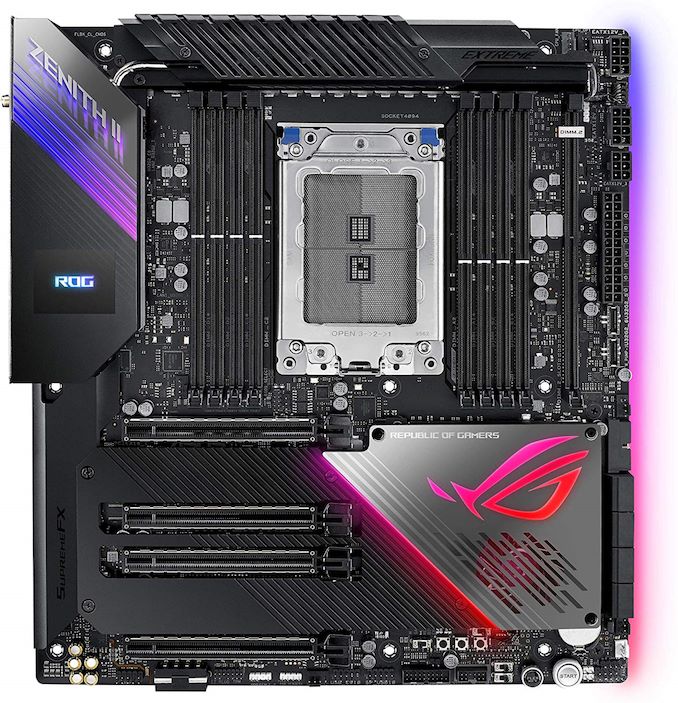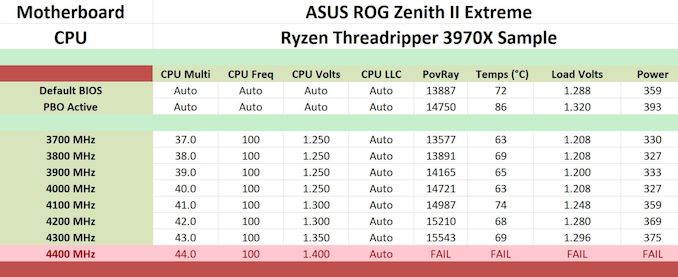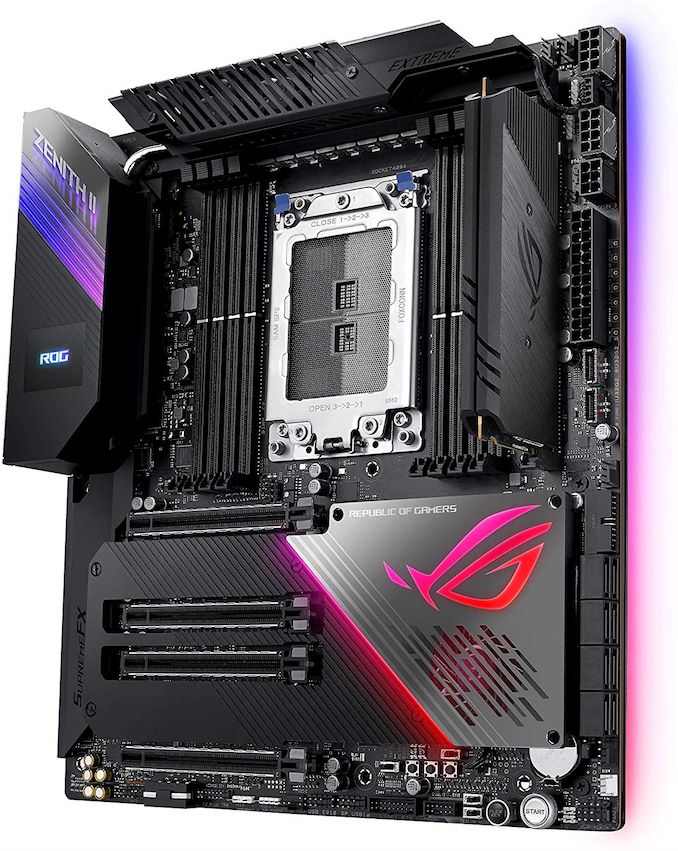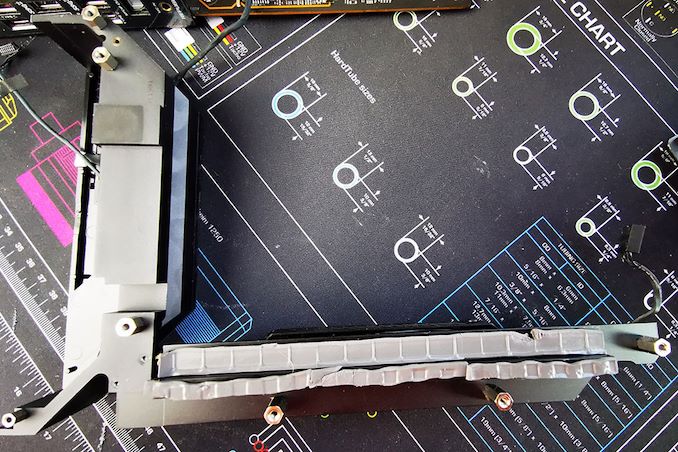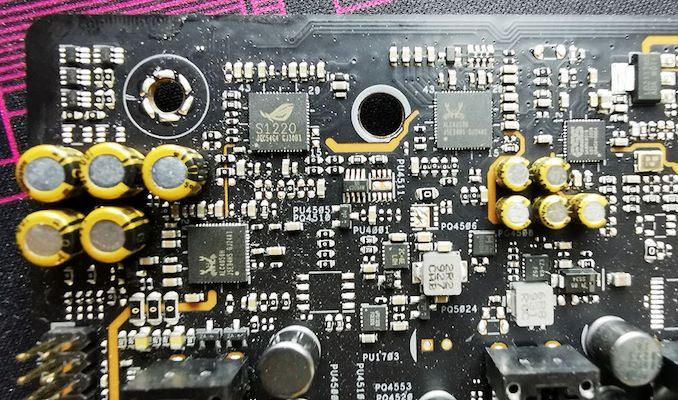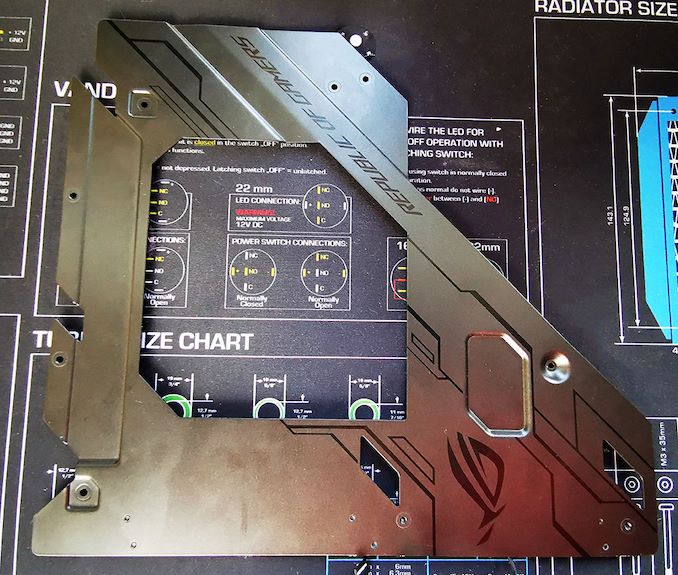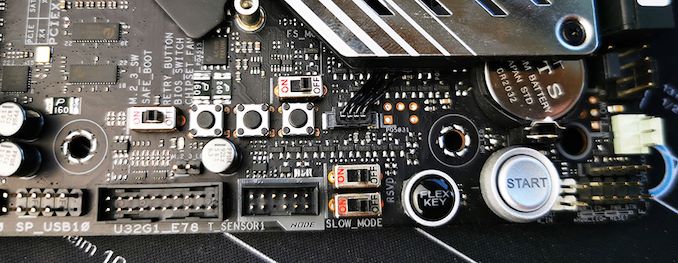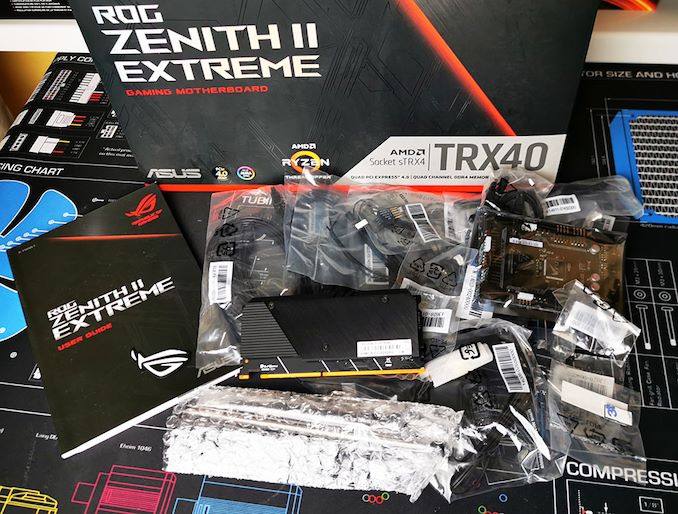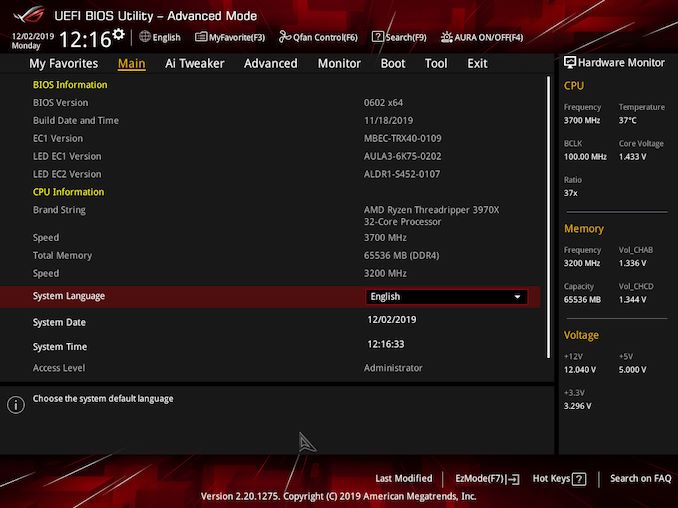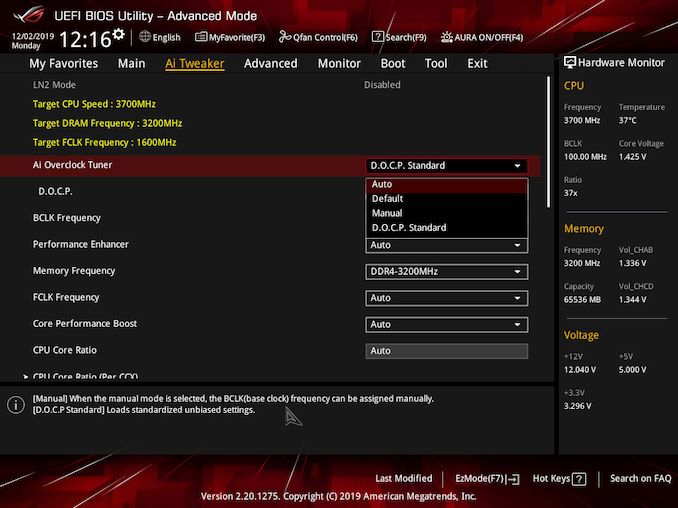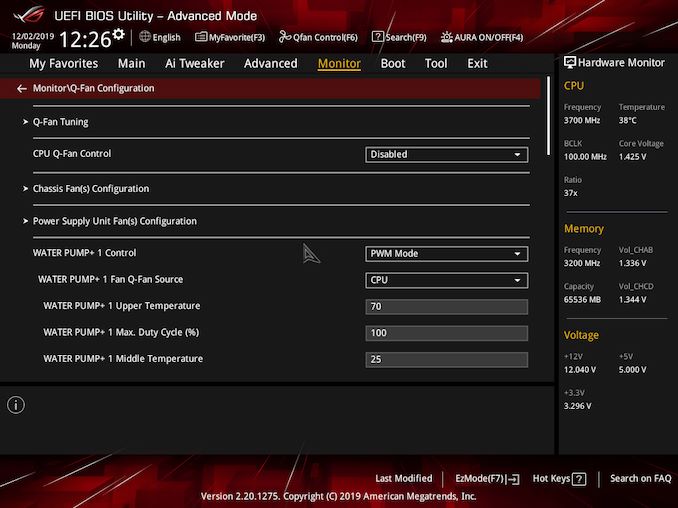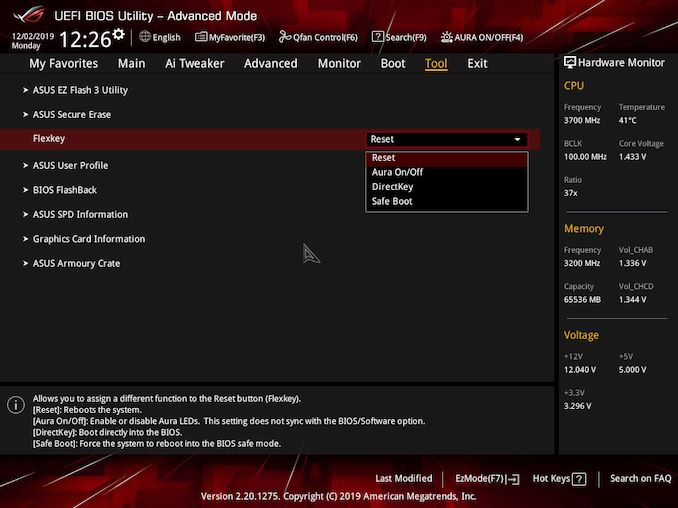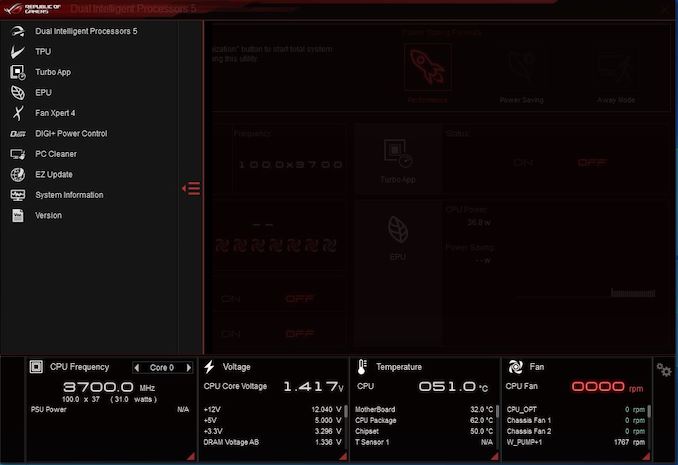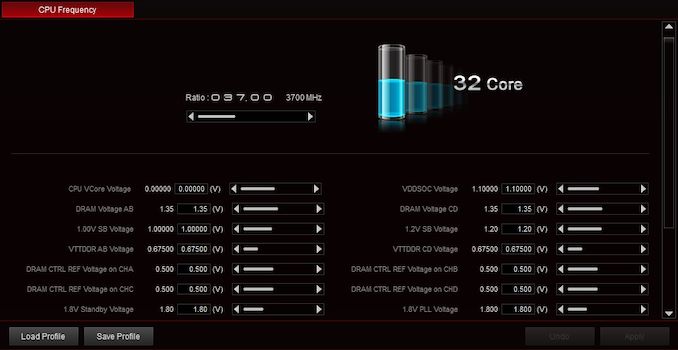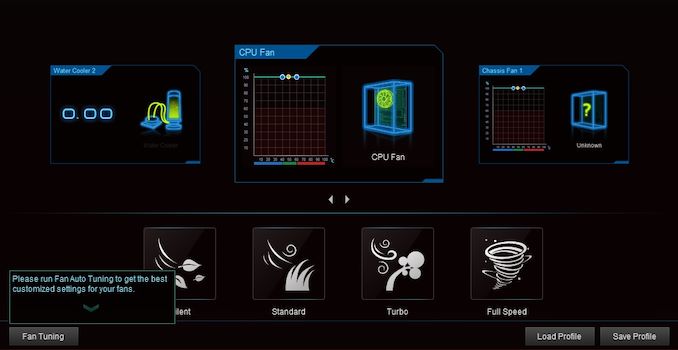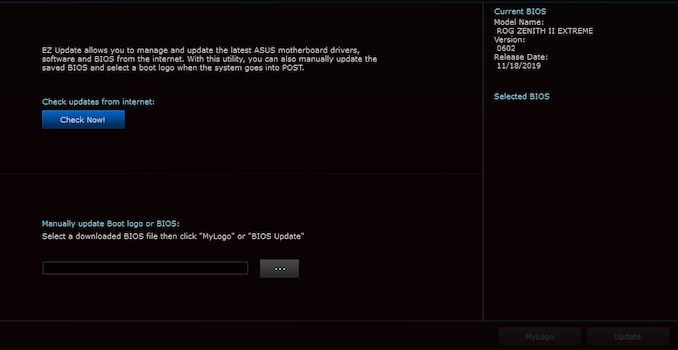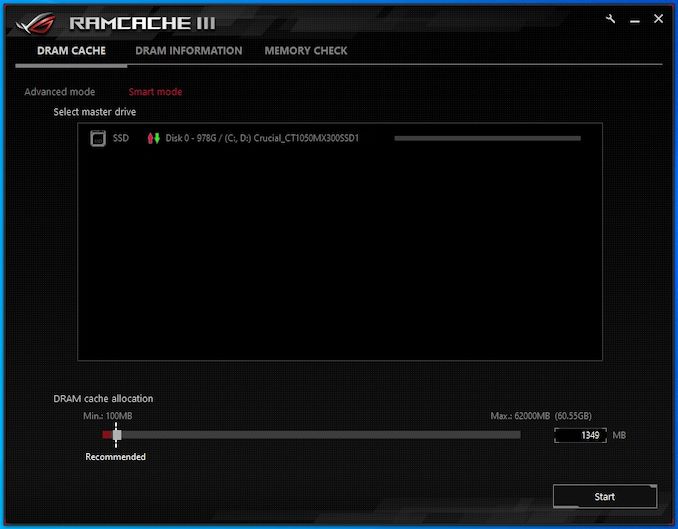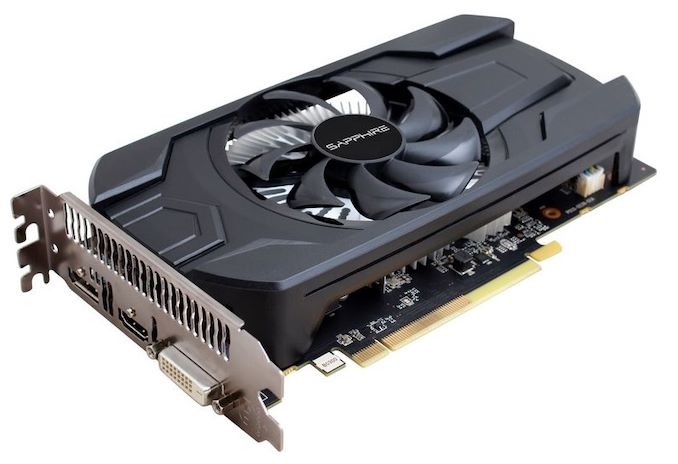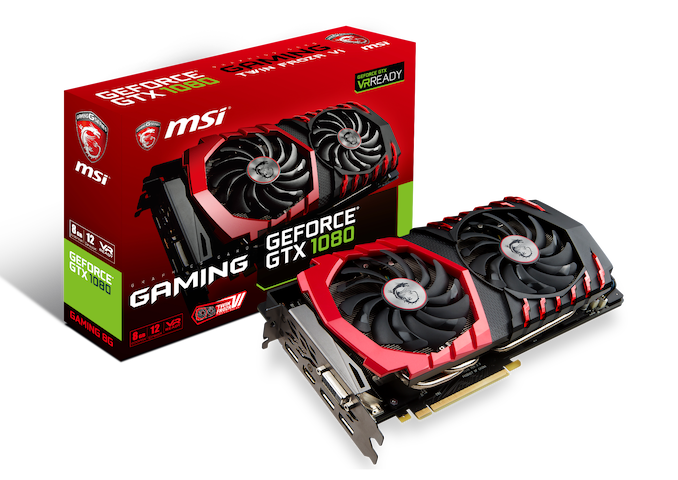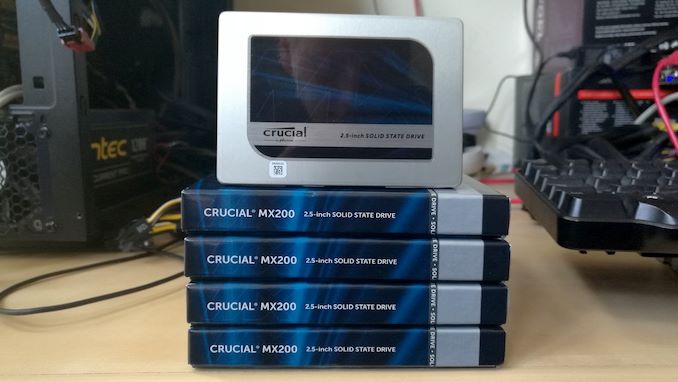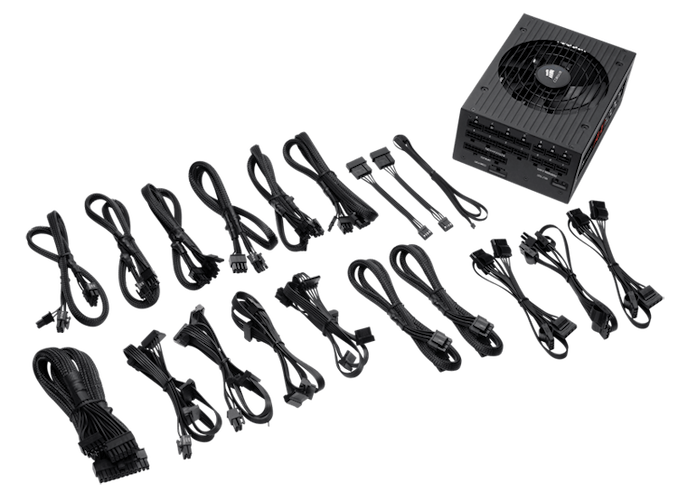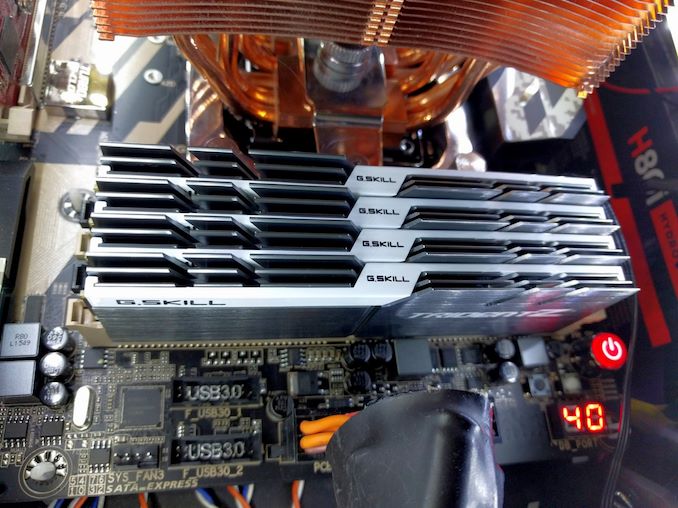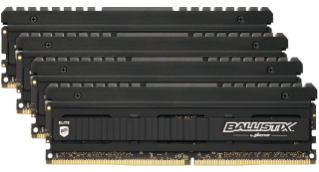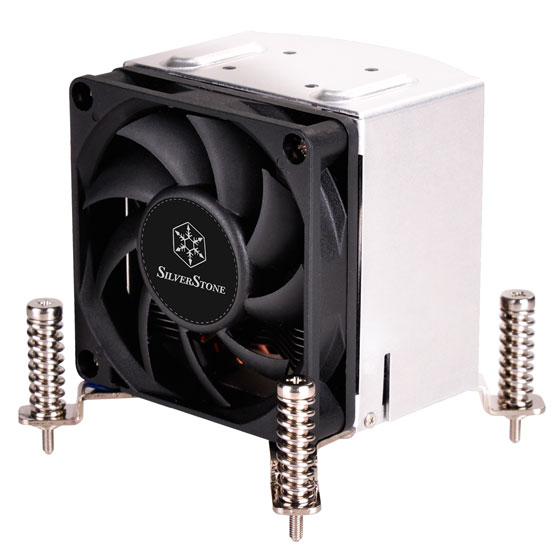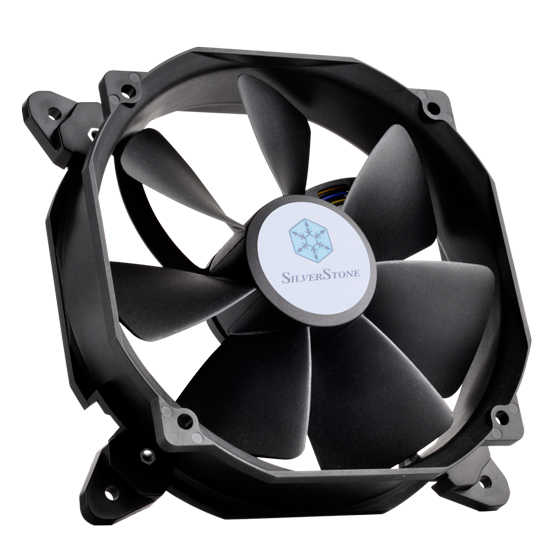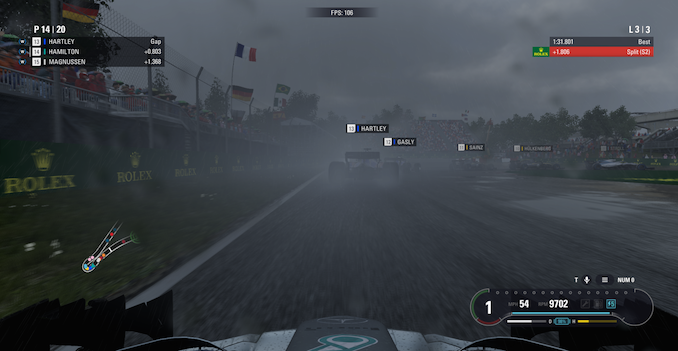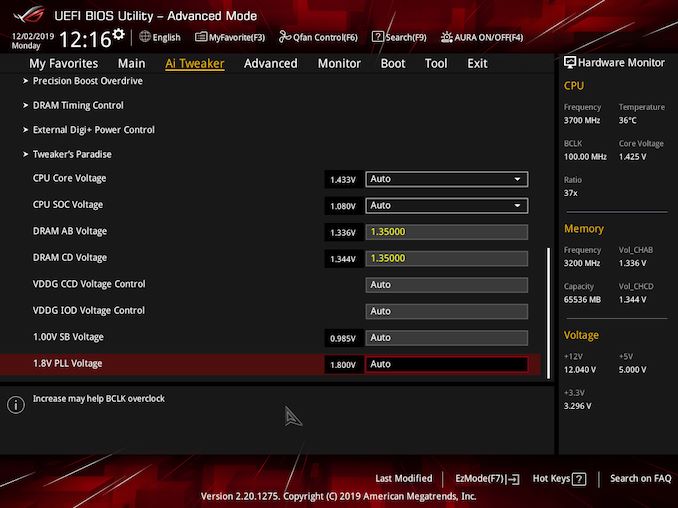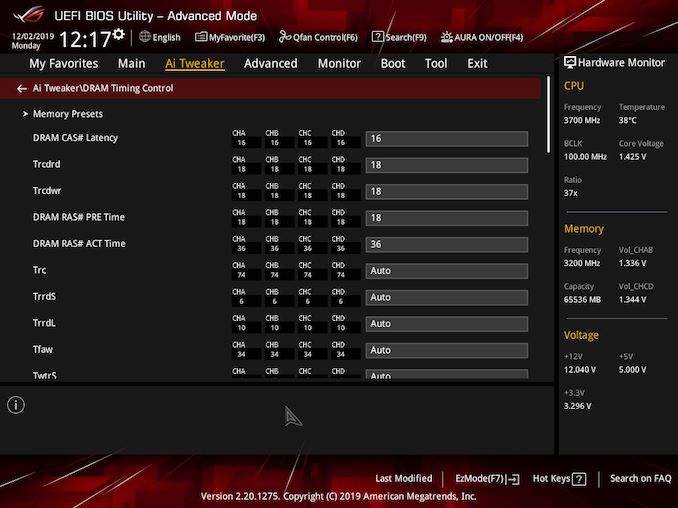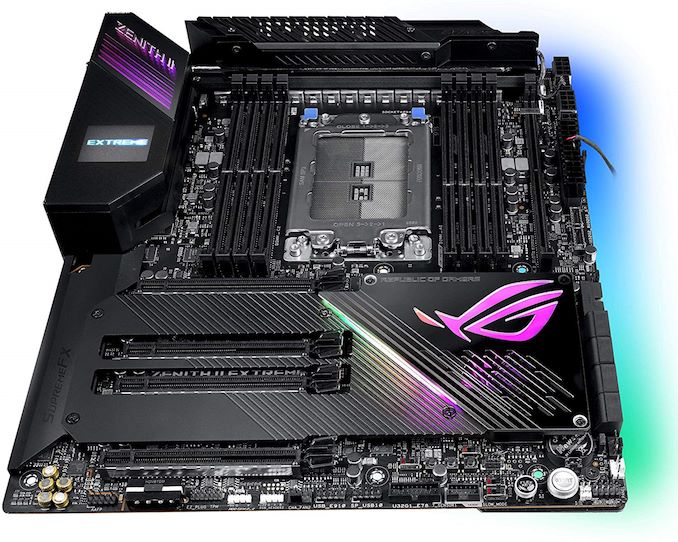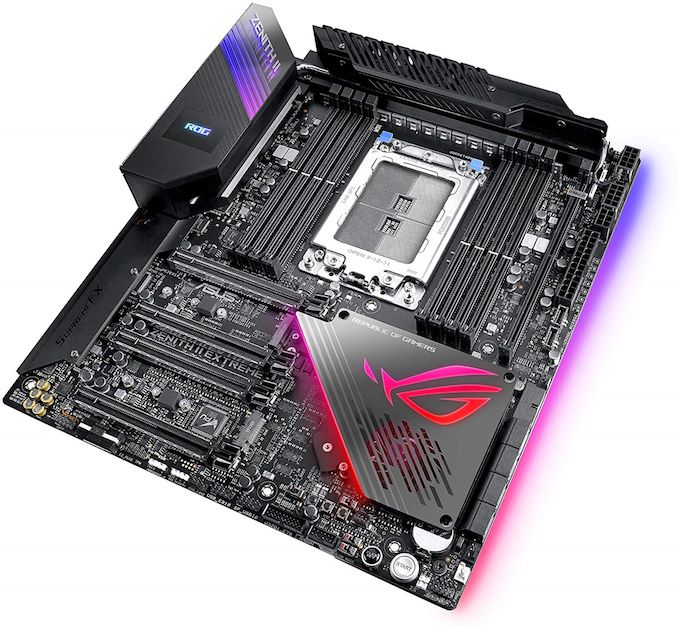
Original Link: https://www.anandtech.com/show/15152/asus-rog-zenith-ii-extreme-review
The ASUS ROG Zenith II Extreme TRX40 Motherboard Review: The Second Coming
by Gavin Bonshor on December 23, 2019 9:00 AM EST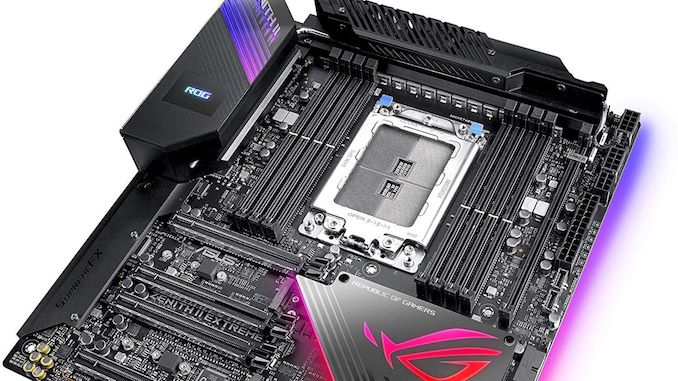
Following on from our launch day AMD Ryzen Threadripper 3970X and 3960X CPU reviews, we are taking a look at the accompanying flagship model from ASUS. The ASUS ROG Zenith II Extreme is the successor to ASUS's previous generation X399 board, the original Zenith Extreme, and comes packed with all the benefits of AMD's TRX40 chipset. This includes PCIe 4.0, a strong USB 3.1 G2 implementation, and support for up to DDR4-4733 in quad-channel across eight memory slots. With a 16-phase power delivery for the CPU and a LiveDash 1.77'' OLED color screen, the ROG Zenith II Extreme looks to set the standard for enthusiasts on AMD's new high-end desktop platform.
Not all motherboards are created equally and for the same purpose, even on the same chipset. Prime examples of this come in how a vendor markets its models with ASUS good at distinguishing its different models including the ASUS ROG Strix TRX40-E Gaming, and the more professional focused ASUS Prime TRX40-Pro. Having a strong brand identity is beneficial for users. On AMD's latest TRX40 chipset, designed for socket sTRX40 processors including the AMD Ryzen Threadripper 3970X and 3960, ASUS released a total of three new models for users to utilize the high-core and thread count. The most notable of the three designs is the ASUS ROG Zenith II Extreme which sits as the brand's flagship for TRX40 with a lot of bells and whistles you would associate with a top tier model on a top tier HEDT platform.
The Second Coming: ROG Zenith II Extreme
The ASUS ROG Zenith II Extreme is the second coming of the Zenith for AMD with the previous version designed for the X399 chipset; we actually reviewed the ASUS X399 ROG Zenith Extreme model last year. Some major refinements have been made with plenty of USB 3.1 G2 utilization due to more support natively through the TRX40 chipset, with TRX40 also pushing PCIe 4.0 onto the chipset, as X570 has done with the mainstream. On the aesthetics, ASUS has gone with a primarily black design, with a contrasting gun-metal grey on the chipset heatsink area.
Incorporating a full cover design that stretches around the rear panel and the PCIe slot area, the aesthetic is clean and sleek, which fits the flagship status of this board very well. The ASUS ROG Zenith II Extreme does have integrated RGB LEDs with an illuminated ROG logo on the chipset heatsink, RGB on the rear panel cover, and a strip on the underside of the PCB at the right-hand side. ASUS has also incorporated its LiveDash 1.77" color OLED panel which can display custom GIFs, or be used as a POST debugger.
The core feature set is devised of a solid showing on the networking front with an Aquantia AQC107 10 Gigabit Ethernet controller, with assists going to an Intel I211-AT Gigabit controller, and an Intel AX200 Wi-Fi 6 wireless interface. Other primary features include three PCIe 4.0 x4 M.2 slots onboard with each slot complemented by an M.2 heatsink, while users can add a further two PCIe 4.0 x4 M.2 slots via the included ROG DIMM.2 module. This means users can install up to five PCIe 4.0 x4 M.2 drives into the ROG Zenith II Extreme. Also present is eight SATA ports with four coming from the chipset and has support for RAID 0, 1, and 10 arrays, while the other four are driven by a pair of ASMedia SATA controllers. There are four CPU driven full-length PCIe 4.0 slots that operate at x16/x8/x16/x8.
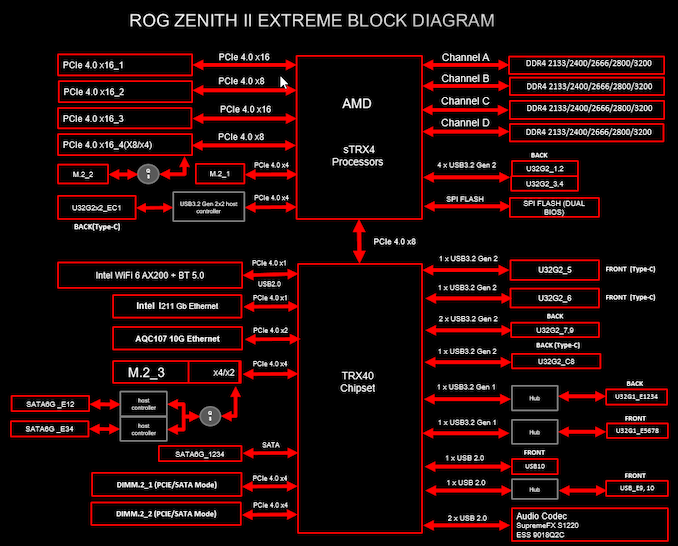
ASUS ROG Zenith II Extreme Block Diagram
On the power delivery is a 16-phase layout with sixteen TDA21472 70A power stages. ASUS has been pretty guarded about which PWM controller it's using for its TRX40 models, but we know it is using an ASP1405I controller which is similar to the Infineon IR35201. Delivering power to the board as a whole is a trio of connectors including two 8-pin 12V CPU inputs, and one 6-pin PCIe power input. The ASUS ROG Zenith II Extreme also includes support for DDR4-4733, with up to 256 GB in quad-channel mode supported across eight memory slots.
Focusing on the performance, the ASUS ROG Zenith II Extreme is very competitive with other TRX40 models we've tested. It does run with a slightly higher power draw than other models, but with a LiveDash 1.7" OLED screen, plenty of integrated RGB, a premium controller set, and extra cooling fans for the power delivery, this is to be expected. The biggest win for the second iteration of the Zenith Extreme was in our POST test, with the ASUS model performing very well. In our computational tests and gaming tests, we saw no anomalies with our Ryzen Threadripper 3970X. Overall performance is on the level we expect and is comparable with the other models on we have put on test so far.
The ASUS ROG Zenith II Extreme has plenty of overclocking features. ROG boards have been at the forefront of overclocking for many years and the Zenith II Extreme is no different. The board includes an overclocker's toolkit, with firmware that ASUS states is designed to maximise performance with AMD's Ryzen Threadripper 3000 processors. In our testing with the AMD Ryzen Threadripper 3970X, we managed to hit a stable overclock of 4.30 GHz. Stepping up from 3.7 GHz to 4.0 GHz at 1.25 V on the CPU VCore, we observed good levels of VDroop ranging with load CPU VCore voltages of being 1.200 and 1.208 V. Going up to 4.1 GHz and up to our maximum stable overclock of 4.3 GHz, the VDroop was lower, but still well within what is acceptable. When overclocking a 32-core processor like the Ryzen Threadripper 3970X, cooling is a factor that needs to be considered, and we opted for a 360 mm for good measure.
At present, the ASUS ROG Zenith II Extreme ($850) has just one competitor within its price segment, the GIGABYTE TRX40 Aorus Xtreme ($850) which is a clear rival in terms of features and design. While not much separates both models on paper, it all comes down to the aesthetics and ultimately, the performance. The ASUS ROG Zenith II Extreme is a solid example of a premium flagship on what is one of the most talked-about platforms all year. Comparing pricing to AMD's more consumer-focused desktop X570 chipset, flagships from vendors on both X570 and TRX40 are similar in terms of price ($800-900), and with the added cost of an AMD Ryzen 3rd generation Threadripper processor factored in, ASUS is aiming high with the Zenith II Extreme, and it certainly shows in the feature set and the aesthetics.
Read on for our extended analysis.
Visual Inspection
The ASUS ROG Zenith II Extreme is an E-ATX motherboard that retails for $850 and sits at the top of its current TRX40 product stack. It has a stacked PCB which is mostly hidden by an aluminium PCB cover which doubles up as a heatsink for two of the five available PCIe 4.0 x4 M.2 slots. The rear panel cover is also crafted from aluminium and includes a LiveDash 1.77" OLED color screen which allows users to customize the look via GIFs, temperature and system usage data, or as a POST debugger. Around the board are integrated RGB LEDs with three customizable zones; the rear panel cover, the ROG logo within the chipset heatsink, and on the right-hand side of the board. ASUS also includes two AURA RGB strip headers, and two addressable RGB headers for users to expand on what's included out of the box.
One of the main benefits of the TRX40 chipset is the introduction of PCIe 4.0 to the high-end desktop. The ASUS ROG Zenith II Extreme has plenty of connectivity with four full-length PCIe 4.0 slots which operate at x16/x8/x16/x8. Touching on the storage capabilities onboard, there is scope to install up to five PCIe 4.0 x4 M.2 drives onto the board. Two of the PCIe 4.0 x4 M.2 slots are hidden underneath the aluminium armor, while a single slot is located on the rear of the PCB, albeit without a heatsink. Included in the accessories bundle is a ROG DIMM.2 module which allows users to install a further two PCIe 4.0 x4 M.2 drives onto the board.
The ROG Zenith II Extreme also has eight memory slots which have support for DDR4-4733 and up to 256 GB of system memory. Users can equip ECC memory, but only un-buffered ECC. Non-ECC UDIMMs work as well.
Connectivity is a big thing for ASUS on its flagship model with lots of internal IO including seven 4-pin headers split into two for CPU fans, two for water pumps, two for chassis fans, and one for a high amp fan. For overclockers are seven Probelt voltage measurement points, three water temperature sensor input and outputs, and a node connector. There are also two USB 3.2 Gen2 front panel connectors which allow users to add extra USB devices on top of what's available on the rear panel.
The ASUS ROG Zenith II Extreme is using a 16-phase power delivery which is being controlled by an ASUS specific ASP1405I PWM controller. This essentially is a rebadged Infineon IR35201 PWM controller which is running in 8+0. and ASUS is running its phases in teamed mode, rather than in a doubled mode, which helps to reduce transient response and doesn't require doublers. Just like the ASUS ROG Crosshair VIII Impact which we reviewed, ASUS has doubled the phase count. The pitfall is that this type of power delivery requires a higher frequency signal duplication from the controller, rather than splitting the signal with a doubler. This isn't doubling in the regular sense of the word, as the design means that the phases run in parallel. Providing power to the processor is two 8-pin CPU power connections, and a 6-pin PCIe input.
Cooling the large 16-phase power delivery is a large aluminium finned heatsink which is aided with two small Delta Superflo fans. They are designed to spin up once the temperatures hit 60°C, which negates extra noise, and affords extra cooling when it is needed. The power delivery heatsink is interconnected by a heat pipe to the large aluminium rear panel cover, and stretches around the majority of the top side of the board. The chipset and PCIe armor are separated, while the chipset heatsink does have the added benefit of a cooling fan for when the TRX40 chipset is loaded up with PCIe 4.0 x4 M.2 drives.
Although ASUS doesn't mention it in the official specifications. it is using a Realtek ALC4050H audio codec to bridge the USB interface to the I2S. This is due to AMD not including support for an HD audio interface on the TRX40 chipset. Without the Realtek ALC4050H codec, the Supreme S1220 codec simply wouldn't work with the chipset and needs to use USB 2.0 to dial into the interface to interconnect the S1220. The audio PCB features separation from the rest of the board and uses ten gold Japanese audio capacitors. ASUS also includes an ESS Sabre ESS9018Q2C DAC to further enhance users auditory experience.
At the rear of the board is a large black steel backplate which serves a couple of purposes. Not only does it add extra re-inforcement to reduce the risk of bending, but it also adds extra mass onto the rear of the power delivery which can funnel some of the heat. Interestingly, ASUS has mounted a single PCIe 4.0 x4 M.2 slot on the back, but has opted not to include a heatsink within any part of the design of the backplate.
It wouldn't be an Extreme branded Republic of Gamers model without included an overclocker's toolkit, although this is more aimed towards the enthusiast-level user and extreme overclockers. Located in the bottom right-hand corner of the board is a power button, a flex key which can be assigned to different functions within the firmware. Also featured is a set of dip switches including a dual BIOS switch, a slow mode switch, an RSVD switch, and an LN2 mode switch. There are also a few buttons including one for OC retry and one for booting the system into safe mode. For cooling, there are seven 4-pin headers with two dedicated for CPU fans, one for a high amp fan, two for water pumps, and two for regular chassis fans.

On the rear panel is a total of ten USB connectors including five USB 3.1 G2 Type-A, four USB 3.1 G1 Type-A, and a single USB 3.2 G2 20 Gbps Type-C port. ASUS has used most of the TRX40's native USB 3.1 G2 support available. Also present is a pair of buttons with one for resetting the CMOS, and another designated for USB BIOS Flashback. The five 3.5 mm illuminated audio jacks and S/PDIF optical output are powered by a SupremeFX S1220 HD audio codec, while the board has dual port networking with one controlled by an Aquantia AQC107 10 G and the other by an Intel I211-AT Gigabit pair of Ethernet controllers. Finishing off the rear panel is a pair of antenna connectors for the included Intel AX200 Wi-Fi 6 wireless interface which also offers BT 5.0 connectivity.
What's in The Box
Included with the ASUS ROG Zenith II Extreme is a packed accessories bundle with some of the most notable inclusions coming by the way of an Intel AX200 Wi-Fi 6 antenna, five M.2 screws, a ROG DIMM.2 module with heatsinks, a USB drive containing the boards drivers and software package, six SATA cables, and a ROG Fan Extention Card. Also included is plenty of ASUS ROG merchandise including a ROG coaster, a large ROG sticker sheet, and a ROG plate sticker which can be affixed to a chassis, or anywhere that it would look good.
- User manual
- USB software and drivers installation drive
- ROG DIMM.2 module with heatsinks
- 6 x SATA cables
- 5 x M.2 installation screws
- 3-in-1 Thermistor cable
- Front panel Q-Connector
- Intel AX200 Wi-Fi 6 moving antenna
- ASUS Fan Extension Card II
- Dual function screwdriver
- 2 x 80 cm RGB Extension cables
- ROG Coaster
- ROG large sticker sheet
- ROG logo plate sticker
BIOS
The ASUS ROG firmware is consistent throughout its range with a red, grey, and black theme throughout. The text is white and uses a deep red color when each setting or selection is highlighted. There are seven primary menus including Ai Tweaker for overclocking, Advanced for chipset and AMD specific options, and tools which allow users to update the board's firmware.
Pressing the F7 key allows users to select between the EZ and Advanced modes. The EZ mode displays basic information about the processor including core clock speed, CPU Core voltage, and temperature. Users can enable X.M.P profiles which ASUS calls D.O.C.P on its AMD models. The main screen of the advanced section is similar, but it allows users to change language settings and has a hardware monitor panel on the right-hand side.
The AI Tweaker opens up a gateway to the world of overclocking on AMD's HEDT Threadripper processors, with lots of room to tweak power settings and memory latencies. This also includes options to increase the FCLK/Infinity Fabric frequency which means users with faster memory can benefit more from AMD's interconnect. Just like X570, TRX40 also supports AMD's Precision Boost Overdrive settings and the firmware does have extensive options available.
Below is a list of limitations when using the current firmware for settings such as CPU VCore, CPU frequency, DRAM frequency, and the Infinity Fabric/FCLK frequency. It should be noted that most of these maximum values won't even be able to be reached, even with extreme cooling methods:
- Maximum CPU Frequency = 6.375 GHz
- Maximum CPU VCore = 1.5 V
- Maximum DRAM Frequency = DDR4-6000
- Maximum Infinity Fabric/FCLK Frequency = 3000 MHz
Note - We didn't enable LN2 mode at any point during our testing as we didn't want to risk potential damage to our testbed hardware.
Within the hardware monitor section, ASUS has included its Q-Fan control and allows users to customize fan profiles. The GUI is a little archaic, but users can customize all of the 4-pin headers individually, as well as control the chipset heatsink fan, and the cooling fans attached to the power delivery heatsink. Each fan can be controlled based on temperature variables including upper, middle, and lower temperature limits. Users can opt between PWM or DC mode depending on what the chassis fans support.
The tools section includes the ASUS EZ Flash 3 Utility for flashing the board's firmware, BIOS Flashback, and access to the ASUS Armoury Crate. The Armoury Crate includes drivers and software, which users can install straight from first boot into Windows; users can opt to turn this feature off under the ASUS Armoury Crate settings.
Overall, the ASUS ROG firmware is very responsive to clicks and key presses, it's GUI is consistent throughout the board, and it's functional. The Q-Fan settings could be a little better with a fan curve customization tool instead of its prehistoric settings input, but there are plenty of settings available for tweakers to get the most out of TRX40 and the Threadripper platform.
Software
The Armoury Crate is a small pool of integrated storage where users can install drivers and software within Windows; this is promoted during a fresh Windows 10 installation (this can be disabled in the BIOS). Users have the option to utilize the Armoury Crate or download and install the latest updates directly from the official product page, but the ASUS armoury crate does save time. The most notable software included with the software bundle is the ROG AI Suite which acts as a central hub to the majority of the software, the ROG Aura RGB LED utility, and the ROG RAM Cache III software.
Following with what many vendors are doing, ASUS ROG has amalgamated most of its software into one easy to use package. The ROG AI Suite combines the previous AI Suite 3 overclocking software with other functions such as the PC Cleaner, DIGI+ Power controls, the Fan Xpert 4 control software, and an EZ Update firmware updater.
Within the Turbo App section, users can overclock the processor within the software. There is plenty of options to customize CPU frequency, with even more voltage options available, including memory voltage settings. This offers an alternative to AMD's own Ryzen Master software, although Ryzen Master does offer much more including CCD control, and per-core clock speed customization.
The Fan Xpert 4 utility allows users to customize each 4-pin fan header installed onto the board. Users can set each fan to operate from a customized fan profile or select from one of four preset profiles. ASUS also offers a Fan Tuning setting which does everything automatically based on set parameters including temperature; this is likely determined from a lookup table.
Not only can users update the firmware in the BIOS, but it can be done within the EZ Update section of the ROG AI Suite software. There are options to check if the latest firmware is installed, as well as update the firmware from a file, and users can even upload a customized MyLogo to display during system POST.
The ROG RAMCACHE III software allows users to create a pool of super-fast storage from installed memory. This is useful if users want to load certain applications with the benefits of the high bandwidth memory has over standard storage solutions. With the TRX40's ability to use up to 256 GB of system memory, this is more functional on HEDT platforms with better memory support, over desktop platforms; everything is relative to the amount of memory.
Overall the software bundle supplied whether users download it from the official product page, install it from the supplied USB flash drive, or through the functionality of the ROG Armory Crate, there is plenty for users to sink their teeth into. Users looking to install sound software will need to do so from the Windows Store as it isn't included in the bundle, nor is it available for download on the official product page.
Board Features
The ASUS ROG Zenith II Extreme is currently the companies flagship motherboard on the AMD TRX40 chipset. With an EATX frame, it comes packed with a high-end feature set which is spearheaded by its trio of networking controllers. This includes an Aquantia AQC107 10 Gigabit ethernet controller, and Intel I211-AT Gigabit Ethernet controller, as well as an Intel AX200 Wi-Fi 6 wireless interface which integrates BT 5.0 connectivity. Storage options include three PCIe 4.0 x4 M.2 slots which include integrated heatsinks, with ASUS's ROG DIMM.2 slot and module which allows users to install two more PCIe 4.0 x4 M.2 drives. Although the ROG Zenith II Extreme has eight SATA ports. only four have support for RAID 0, 1, and 10 arrays, as the other four are controlled by ASMedia SATA controllers. There are four full-length PCIe 4.0 slots that run at x16/x8/x16+x8, while the board uses eight memory slots supporting up to DDR4-4733 and up to 256 GB.
| ASUS ROG Zenith II Extreme EATX Motherboard | |||
| Warranty Period | 3 Years | ||
| Product Page | Link | ||
| Price | $850 | ||
| Size | EATX | ||
| CPU Interface | sTRX4 | ||
| Chipset | AMD TRX40 | ||
| Memory Slots (DDR4) | Eight DDR4 Supporting 256 GB Quad Channel Up to DDR4-4733 |
||
| Video Outputs | N/A | ||
| Network Connectivity | Aquantia AQC107 10 G Intel I211-AT 1 G Intel AX200 Wi-Fi 6 802.11ax |
||
| Onboard Audio | SupremeFX S1220 ESS Sabre 9018Q2C |
||
| PCIe Slots for Graphics (from CPU) | 4 x PCIe 4.0 x16 (x16/x8/x16/x8) | ||
| PCIe Slots for Other (from PCH) | N/A | ||
| Onboard SATA | Four, RAID 0/1/10 (TRX40) Four, (ASMedia) |
||
| Onboard M.2 | 3 x PCIe 4.0 x4 2 x PCIe 4.0 x4 (ROG DIMM.2) |
||
| USB 3.2 (20 Gbps) | 1 x Type-C Rear Panel | ||
| USB 3.1 (10 Gbps) | 6 x Type-A Rear Panel 1 x Type-C Rear Panel |
||
| USB 3.0 (5 Gbps) | 4 x Type-A Rear Panel 2 x Type-A Header (4 x ports) |
||
| USB 2.0 | 2 x Type-A Header (3 x ports) | ||
| Power Connectors | 1 x 24-pin ATX 2 x 8pin CPU 1 x 6pin CPU |
||
| Fan Headers | 1 x CPU (4-pin) 1 x Water Pump (4-pin) 3 x System (4-pin) |
||
| IO Panel | 6 x USB 3.1 G2 Type-A 4 x USB 3.1 G2 Type-A 1 x USB 3.2 G2 Type-C 1 x USB 3.1 G2 Type-C 1 x Network RJ45 10 G (Aquantia) 1 x Network RJ45 1 G (Intel) 5 x 3.5mm Audio Jacks (SupremeFX) 1 x S/PDIF Output (SupremeFX) 2 x Intel AX200 Antenna Ports 1 x USB BIOS Flashback Button 1 x Reset CMOS Button |
||
As AMD's TRX40 chipset features more native support for USB 3.1 G2 connectivity, ASUS as tried to utilize as much as possible with six USB 3.1 G2 Type-A, and one USB 3.1 G2 Type-C port on the rear panel. An ASMedia ASM2342 USB controller powers the single 20 Gbps USB 3.2 G2 Type-C port. There is also four USB 3.1 ports G1 Type-A ports, with up to four additional ports via two USB 3.1 headers. Due to the target market of the top ASUS ROG motherboards, it is overclocking friendly by default and offers more extreme users access to a wide range of overclocking variables through the LN2 mode jumper. Also present is an overclocker's toolkit which includes a power button, a reset button, and RSVD switch, a safe boot button, and seven probelt measurement points. The LiveDash 2 OLED 1.77'' screen during POST acts as a debugger and can be set to display different variables through the software including CPU usage, and temperature.
Test Bed
As per our testing policy, we take a high-end CPU suitable for the motherboard that was released during the socket’s initial launch and equip the system with a suitable amount of memory running at the processor maximum supported frequency. This is also typically run at JEDEC subtimings where possible. It is noted that some users are not keen on this policy, stating that sometimes the maximum supported frequency is quite low, or faster memory is available at a similar price, or that the JEDEC speeds can be prohibitive for performance. While these comments make sense, ultimately very few users apply memory profiles (either XMP or other) as they require interaction with the BIOS, and most users will fall back on JEDEC supported speeds - this includes home users as well as industry who might want to shave off a cent or two from the cost or stay within the margins set by the manufacturer. Where possible, we will extend out testing to include faster memory modules either at the same time as the review or a later date.
While we have been able to measure audio performance from previous Z370 motherboards, the task has been made even harder with the roll-out of the Z390 chipset and none of the boards tested so far has played ball. It seems all USB support for Windows 7 is now extinct so until we can find a reliable way of measuring audio performance on Windows 10 or until a workaround can be found, audio testing will have to be done at a later date.
| Test Setup | |||
| Processor | AMD Ryzen Threadripper 3970X, 280W, $1999 32 Cores, 64 Threads, 3.7 GHz (4.5 GHz Turbo) |
||
| Motherboard | ASUS ROG Zenith II Extreme (BIOS 0602 - PI1.0.0.2) | ||
| Cooling | Thermaltake Floe Riing RGB 360 | ||
| Power Supply | Thermaltake Toughpower Grand 1200W Gold PSU | ||
| Memory | Corsair Dominator Platinum RGB 4x8 GB DDR4-3200 | ||
| Video Card | MSI GTX 1080 Gaming 8G | ||
| Hard Drive | Crucial MX300 1TB | ||
| Case | Open Benchtable BC1.1 (Silver) | ||
| Operating System | Windows 10 1909 | ||
Readers of our motherboard review section will have noted the trend in modern motherboards to implement a form of MultiCore Enhancement / Acceleration / Turbo (read our report here) on their motherboards. This does several things, including better benchmark results at stock settings (not entirely needed if overclocking is an end-user goal) at the expense of heat and temperature. It also gives, in essence, an automatic overclock which may be against what the user wants. Our testing methodology is ‘out-of-the-box’, with the latest public BIOS installed and XMP enabled, and thus subject to the whims of this feature. It is ultimately up to the motherboard manufacturer to take this risk – and manufacturers taking risks in the setup is something they do on every product (think C-state settings, USB priority, DPC Latency / monitoring priority, overriding memory sub-timings at JEDEC). Processor speed change is part of that risk, and ultimately if no overclocking is planned, some motherboards will affect how fast that shiny new processor goes and can be an important factor in the system build.
System Performance
Not all motherboards are created equal. On the face of it, they should all perform the same and differ only in the functionality they provide - however, this is not the case. The obvious pointers are power consumption, but also the ability for the manufacturer to optimize USB speed, audio quality (based on audio codec), POST time and latency. This can come down to the manufacturing process and prowess, so these are tested.
For TRX40 we are running using Windows 10 64-bit with the 1909 update as per our Ryzen Threadripper 3960X and 3970X CPU review.
Power Consumption
Power consumption was tested on the system while in a single ASUS GTX 980 GPU configuration with a wall meter connected to the Thermaltake 1200W power supply. This power supply has ~75% efficiency > 50W, and 90%+ efficiency at 250W, suitable for both idle and multi-GPU loading. This method of power reading allows us to compare the power management of the UEFI and the board to supply components with power under load, and includes typical PSU losses due to efficiency. These are the real-world values that consumers may expect from a typical system (minus the monitor) using this motherboard.
While this method for power measurement may not be ideal, and you feel these numbers are not representative due to the high wattage power supply being used (we use the same PSU to remain consistent over a series of reviews, and the fact that some boards on our testbed get tested with three or four high powered GPUs), the important point to take away is the relationship between the numbers. These boards are all under the same conditions, and thus the differences between them should be easy to spot.
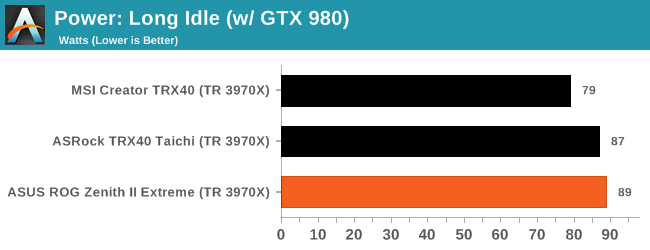
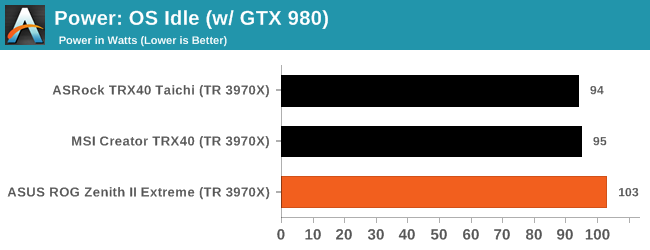
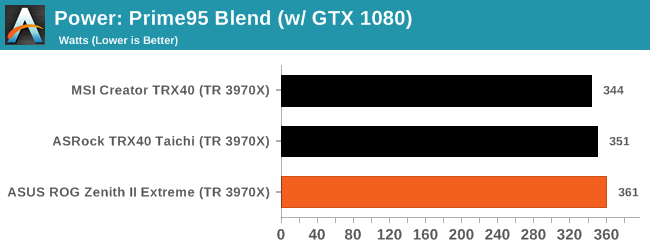
In our power consumption testing, the ASUS ROG Zenith II Extreme has noticeably higher power consumption in all three tests. This can be attributed to the LiveDash OLED panel, as well as multiple premium controllers and componentry on board. At full load, the power is more reasonable with a total power consumption of 361 W, which is 10 W more than the ASRock TRX40 Taichi, and 17 W than the MSI Creator TRX40.
Non-UEFI POST Time
Different motherboards have different POST sequences before an operating system is initialized. A lot of this is dependent on the board itself, and POST boot time is determined by the controllers on board (and the sequence of how those extras are organized). As part of our testing, we look at the POST Boot Time using a stopwatch. This is the time from pressing the ON button on the computer to when Windows starts loading. (We discount Windows loading as it is highly variable given Windows specific features.)
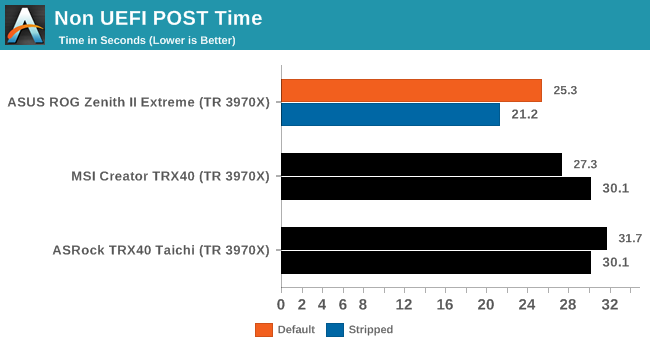
POST times on HEDT platforms can usually be slow, but the ASUS ROG Zenith II Extreme is pretty fast at booting all things considered. With controllers disabled, the ROG Zenith II Extreme is even faster at POSTing with a time of just 21.2 seconds.
DPC Latency
Deferred Procedure Call latency is a way in which Windows handles interrupt servicing. In order to wait for a processor to acknowledge the request, the system will queue all interrupt requests by priority. Critical interrupts will be handled as soon as possible, whereas lesser priority requests such as audio will be further down the line. If the audio device requires data, it will have to wait until the request is processed before the buffer is filled.
If the device drivers of higher priority components in a system are poorly implemented, this can cause delays in request scheduling and process time. This can lead to an empty audio buffer and characteristic audible pauses, pops and clicks. The DPC latency checker measures how much time is taken processing DPCs from driver invocation. The lower the value will result in better audio transfer at smaller buffer sizes. Results are measured in microseconds.
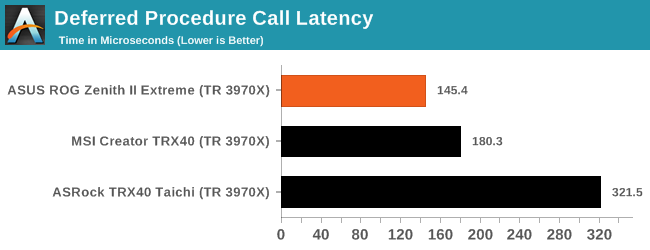
We test the DPC at the default settings straight from the box, and the ASUS ROG Zenith II Extreme did well with a latency time of 145.4 ms. The best we've seen on the TRX40 models we have tested so far.
CPU Performance, Short Form
For our motherboard reviews, we use our short form testing method. These tests usually focus on if a motherboard is using MultiCore Turbo (the feature used to have maximum turbo on at all times, giving a frequency advantage), or if there are slight gains to be had from tweaking the firmware. We put the memory settings at the CPU manufacturers suggested frequency, making it very easy to see which motherboards have MCT enabled by default.
For TRX40 we are running using Windows 10 64-bit with the 1909 update as per our Ryzen Threadripper 3960X and 3970X CPU review.
Rendering - Blender 2.7b: 3D Creation Suite - link
A high profile rendering tool, Blender is open-source allowing for massive amounts of configurability, and is used by a number of high-profile animation studios worldwide. The organization recently released a Blender benchmark package, a couple of weeks after we had narrowed our Blender test for our new suite, however their test can take over an hour. For our results, we run one of the sub-tests in that suite through the command line - a standard ‘bmw27’ scene in CPU only mode, and measure the time to complete the render.
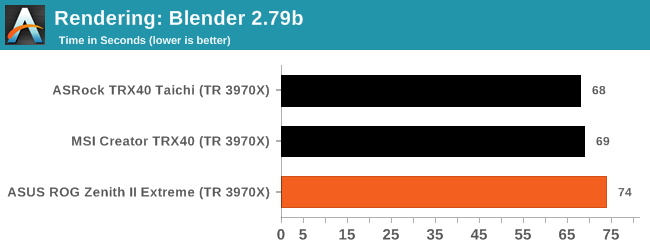
Streaming and Archival Video Transcoding - Handbrake 1.1.0
A popular open source tool, Handbrake is the anything-to-anything video conversion software that a number of people use as a reference point. The danger is always on version numbers and optimization, for example the latest versions of the software can take advantage of AVX-512 and OpenCL to accelerate certain types of transcoding and algorithms. The version we use here is a pure CPU play, with common transcoding variations.
We have split Handbrake up into several tests, using a Logitech C920 1080p60 native webcam recording (essentially a streamer recording), and convert them into two types of streaming formats and one for archival. The output settings used are:
- 720p60 at 6000 kbps constant bit rate, fast setting, high profile
- 1080p60 at 3500 kbps constant bit rate, faster setting, main profile
- 1080p60 HEVC at 3500 kbps variable bit rate, fast setting, main profile
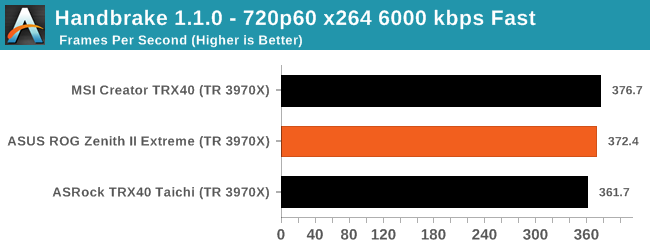
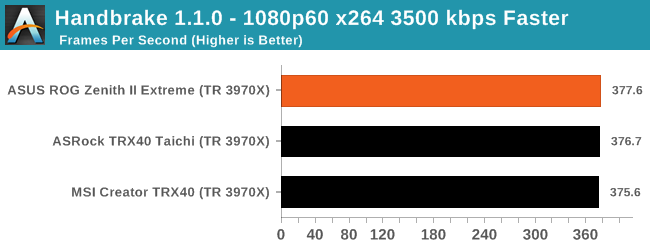
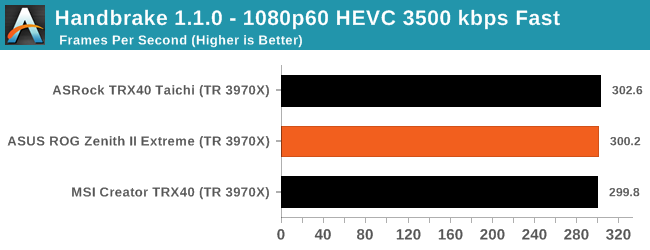
Rendering – POV-Ray 3.7.1: Ray Tracing - link
The Persistence of Vision Ray Tracer, or POV-Ray, is a freeware package for as the name suggests, ray tracing. It is a pure renderer, rather than modeling software, but the latest beta version contains a handy benchmark for stressing all processing threads on a platform. We have been using this test in motherboard reviews to test memory stability at various CPU speeds to good effect – if it passes the test, the IMC in the CPU is stable for a given CPU speed. As a CPU test, it runs for approximately 1-2 minutes on high-end platforms.
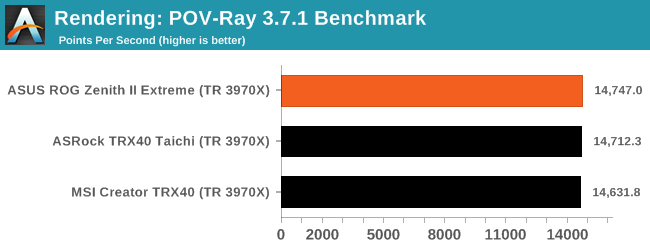
Compression – WinRAR 5.60b3: link
Our WinRAR test from 2013 is updated to the latest version of WinRAR at the start of 2014. We compress a set of 2867 files across 320 folders totaling 1.52 GB in size – 95% of these files are small typical website files, and the rest (90% of the size) are small 30-second 720p videos.
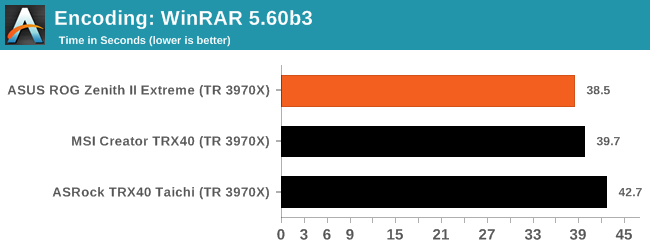
Synthetic – 7-Zip v1805: link
Out of our compression/decompression tool tests, 7-zip is the most requested and comes with a built-in benchmark. For our test suite, we’ve pulled the latest version of the software and we run the benchmark from the command line, reporting the compression, decompression, and a combined score.
It is noted in this benchmark that the latest multi-die processors have very bi-modal performance between compression and decompression, performing well in one and badly in the other. There are also discussions around how the Windows Scheduler is implementing every thread. As we get more results, it will be interesting to see how this plays out.
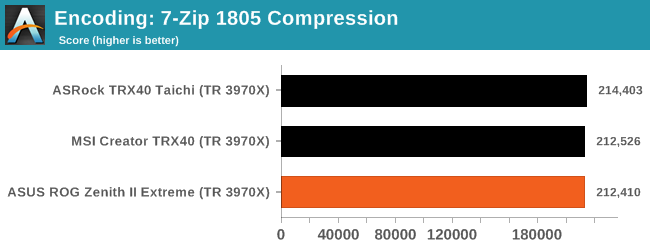
Point Calculations – 3D Movement Algorithm Test: link
3DPM is a self-penned benchmark, taking basic 3D movement algorithms used in Brownian Motion simulations and testing them for speed. High floating point performance, MHz, and IPC win in the single thread version, whereas the multithread version has to handle the threads and loves more cores. For a brief explanation of the platform agnostic coding behind this benchmark, see my forum post here.
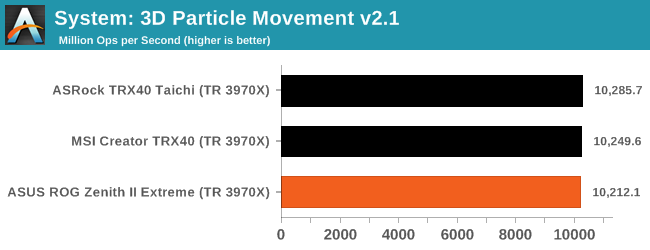
Neuron Simulation - DigiCortex v1.20: link
The newest benchmark in our suite is DigiCortex, a simulation of biologically plausible neural network circuits, and simulates activity of neurons and synapses. DigiCortex relies heavily on a mix of DRAM speed and computational throughput, indicating that systems which apply memory profiles properly should benefit and those that play fast and loose with overclocking settings might get some extra speed up. Results are taken during the steady-state period in a 32k neuron simulation and represented as a function of the ability to simulate in real time (1.000x equals real-time).
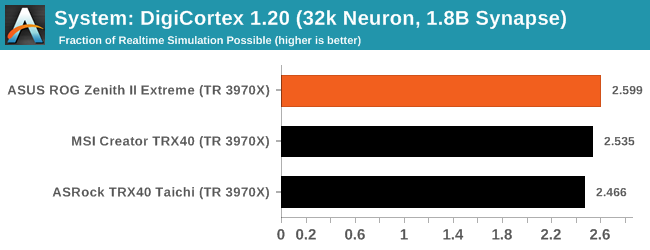
Gaming Performance
For TRX40 we are running using Windows 10 64-bit with the 1909 update as per our Ryzen Threadripper 3960X and 3970X CPU review.
World of Tanks enCore
Albeit different to most of the other commonly played MMO or massively multiplayer online games, World of Tanks is set in the mid-20th century and allows players to take control of a range of military based armored vehicles. World of Tanks (WoT) is developed and published by Wargaming who are based in Belarus, with the game’s soundtrack being primarily composed by Belarusian composer Sergey Khmelevsky. The game offers multiple entry points including a free-to-play element as well as allowing players to pay a fee to open up more features. One of the most interesting things about this tank based MMO is that it achieved eSports status when it debuted at the World Cyber Games back in 2012.
World of Tanks enCore is a demo application for a new and unreleased graphics engine penned by the Wargaming development team. Over time the new core engine will implemented into the full game upgrading the games visuals with key elements such as improved water, flora, shadows, lighting as well as other objects such as buildings. The World of Tanks enCore demo app not only offers up insight into the impending game engine changes, but allows users to check system performance to see if the new engine run optimally on their system.
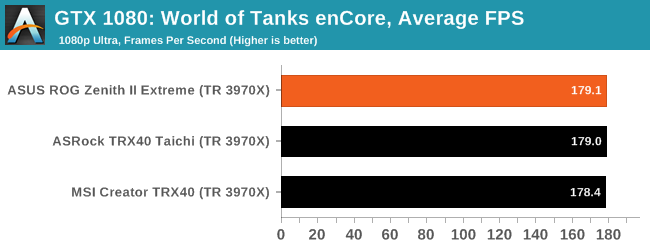
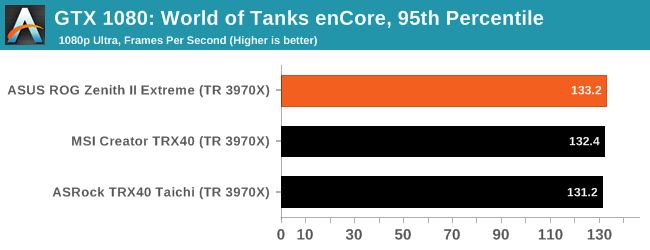
Grand Theft Auto V
The highly anticipated iteration of the Grand Theft Auto franchise hit the shelves on April 14th 2015, with both AMD and NVIDIA in tow to help optimize the title. GTA doesn’t provide graphical presets, but opens up the options to users and extends the boundaries by pushing even the hardest systems to the limit using Rockstar’s Advanced Game Engine under DirectX 11. Whether the user is flying high in the mountains with long draw distances or dealing with assorted trash in the city, when cranked up to maximum it creates stunning visuals but hard work for both the CPU and the GPU.
For our test we have scripted a version of the in-game benchmark. The in-game benchmark consists of five scenarios: four short panning shots with varying lighting and weather effects, and a fifth action sequence that lasts around 90 seconds. We use only the final part of the benchmark, which combines a flight scene in a jet followed by an inner city drive-by through several intersections followed by ramming a tanker that explodes, causing other cars to explode as well. This is a mix of distance rendering followed by a detailed near-rendering action sequence, and the title thankfully spits out frame time data.
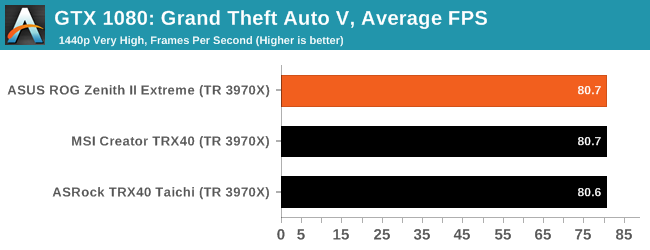
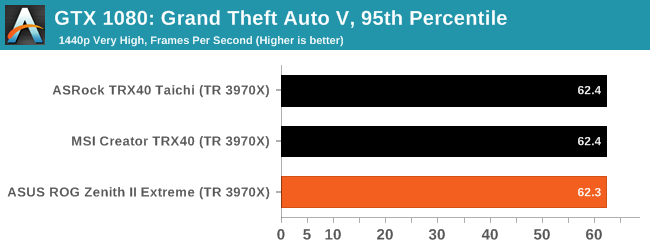
F1 2018
Aside from keeping up-to-date on the Formula One world, F1 2017 added HDR support, which F1 2018 has maintained; otherwise, we should see any newer versions of Codemasters' EGO engine find its way into F1. Graphically demanding in its own right, F1 2018 keeps a useful racing-type graphics workload in our benchmarks.
Aside from keeping up-to-date on the Formula One world, F1 2017 added HDR support, which F1 2018 has maintained. We use the in-game benchmark, set to run on the Montreal track in the wet, driving as Lewis Hamilton from last place on the grid. Data is taken over a one-lap race.
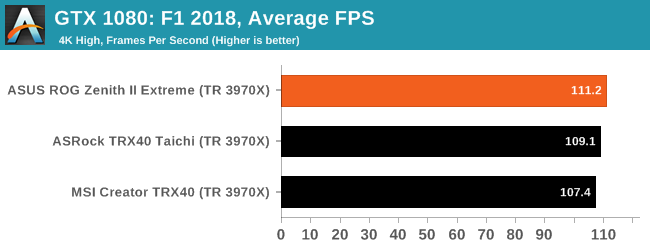
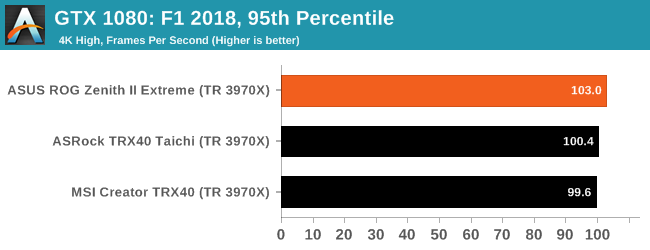
Overclocking Ryzen 3000
Experience with the ASUS ROG Zenith II Extreme
Overclocking with AMD's Ryzen Threadripper 3970X and 3960X is very similar to X570 and Ryzen 3000 processors. The TRX40 and X570 chipset are nearly identical, and the Zen 2 architecture implemented in both the desktop and HEDT variants is very similar. With more cores and more threads, means higher-grade cooling requirements and getting the most from overclocking a 32-core 280W TDP processor needs a strong and capable cooler. The ASUS ROG Zenith II Extreme has plenty of options for overclockers including its hardware-based overclockers toolkit, and a solid firmware with plenty of options available for users to tweak.
ASUS hasn't included any overclocking presets for users to use as a starting point, but the firmware itself is easy to navigate. All of primary overclocking options users need can be found within the Ai Tweaker menu, with plenty of options to overclock both the CPU and memory. Users can enable X.M.P profiles on capable memory kits, which ASUS calls D.O.C.P. For the CPU users can tweak the CPU ratio and BCLK frequencies, as well as set a multitude of voltages aimed at keeping the Threadripper 3000 processors stable.
For the memory, users can build from the available presets which come from ASUS's pool of experienced and extreme overclockers. On the memory latency front, ASUS delivers once again with its DRAM Timing Control and allows users to customize primary, secondary, and tertiary latencies for more control over memory overclocking. The dedicated LN2 mode allows the more ardent enthusiast and extreme overclocker all the extra voltage needed, but it's not recommended to enable for users using ambient cooling. With the overclockers toolkit at the bottom right-hand corner of the board, and the variety of options and menus within the firmware, the ASUS ROG Zenith II Extreme is designed for enthusiasts looking to get the most out of the performance of the Ryzen Threadripper 3000 processors; it's even more than capable of achieving good overclocks depending on the silicon on both ambient and extreme cooling.
Overclocking Methodology
Our standard overclocking methodology is as follows. We select the automatic overclock options and test for stability with POV-Ray and OCCT to simulate high-end workloads. These stability tests aim to catch any immediate causes for memory or CPU errors.
For manual overclocks, based on the information gathered from the previous testing, starts off at a nominal voltage and CPU multiplier, and the multiplier is increased until the stability tests are failed. The CPU voltage is increased gradually until the stability tests are passed, and the process repeated until the motherboard reduces the multiplier automatically (due to safety protocol) or the CPU temperature reaches a stupidly high level (105ºC+). Our testbed is not in a case, which should push overclocks higher with fresher (cooler) air.
Overclocking Results
In our testing with the AMD Ryzen Threadripper 3970X, we managed to hit a maximum stable overclock of 4.30 GHz. This was achieved at 1.350 V on the CPU VCore within the BIOS, and a maximum load CPU VCore of 1.296 V. This is a good level of VDroop and throughout our testing from 3.7 GHz all the way up to 4.3 GHz, VDroop was more than acceptable. ASUS doesn't include any overclocking presets for users to use, but with Precision Boost Overdrive disabled, we saw performance values in POV-Ray of around the 3.8 GHz level. With PBO enabled, the performance was more comparable with our testing at 4.0 GHz on all cores. Performance in POV-Ray, and as a result of the extra MHz and CPU VCore voltage, rose incrementally at every 100 MHz stepping we tested.
No matter what CPU VCore voltage we applied on our Ryzen Threadripper 3970X processor, we couldn't get it stable, although, with 1.400 V on the CPU VCore, we did manage to get it to POST into Windows without issues. The levels of overclocks achieved will depend on the quality of the silicon, cooling methods, and with a high level of power consumption on the 3970X, a good quality power supply can also be a factor; this is to cope with the extra power draw associated with overclocking.
Power Delivery Thermal Analysis
One of the most requested elements of our motherboard reviews revolves around the power delivery and its componentry. Aside from the quality of the components and its capability for overclocking to push out higher clock speeds which in turn improves performance, is the thermal capability of the cooling solutions implemented by manufacturers. While almost always fine for users running processors at default settings, the cooling capability of the VRMs isn't something that users should worry too much about, but for those looking to squeeze out extra performance from the CPU via overclocking, this puts extra pressure on the power delivery and in turn, generates extra heat. This is why more premium models often include heatsinks on its models with better cooling designs, heftier chunks of metal, and in some cases, even with water blocks such as the ASUS ROG Crosshair VIII Formula.
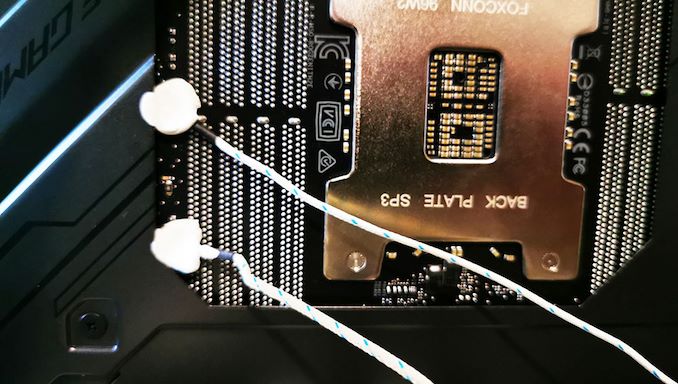
Two K-Type Thermal Probes attached to the rear of the power delivery on the ASUS ROG Zenith II Extreme
Testing Methodology
Out method of testing out if the power delivery and its heatsink are effective at dissipating heat, is by running an intensely heavy CPU workload for a prolonged method of time. We apply an overclock which is deemed safe and at the maximum that the silicon on our AMD Ryzen Threadripper 3970X processor allows. We then run the Prime95 with AVX2 enabled under a torture test for an hour at the maximum stable overclock we can which puts insane pressure on the processor. We collect our data via three different methods which include the following:
- Taking a thermal image from a birds-eye view after an hour with a Flir Pro thermal imaging camera
- Securing two probes on to the rear of the PCB, right underneath CPU VCore section of the power delivery for better parity in case a probe reports a faulty reading
- Taking a reading of the VRM temperature from the sensor reading within the HWInfo monitoring application
The reason for using three different methods is that some sensors can read inaccurate temperatures, which can give very erratic results for users looking to gauge whether an overclock is too much pressure for the power delivery handle. With using a probe on the rear, it can also show the efficiency of the power stages and heatsinks as a wide margin between the probe and sensor temperature can show that the heatsink is dissipating heat and that the design is working, or that the internal sensor is massively wrong. To ensure our probe was accurate before testing, I binned 10 and selected the most accurate (within 1c of the actual temperature) for better parity in our testing.
For thermal image, we use a Flir One camera as it gives a good indication of where the heat is generated around the socket area, as some designs use different configurations and an evenly spread power delivery with good components will usually generate less heat. Manufacturers who use inefficient heatsinks and cheap out on power delivery components should run hotter than those who have invested. Of course, a $700 flagship motherboard is likely to outperform a cheaper $100 model under the same testing conditions, but it is still worth testing to see which vendors are doing things correctly.
Thermal Analysis Results
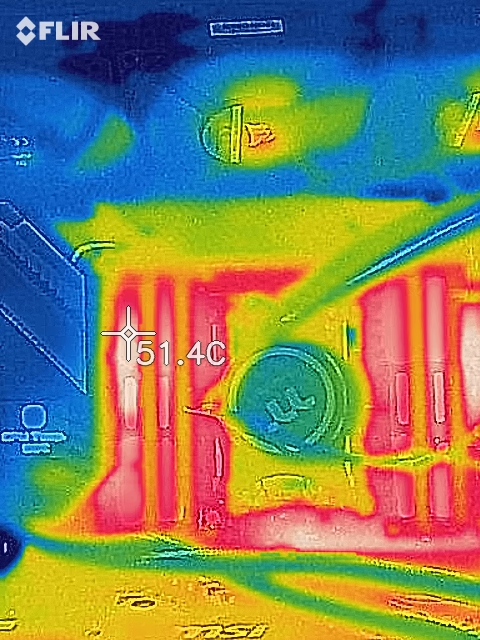
We measured 51.4 °C on the hottest part of the board during our testing; the RAM slots.
The ASUS ROG Zenith II Extreme is using a 16-phase power delivery with sixteen Infineon TDA21472 70 A power stages operating in teamed mode. This is possible due to ASUS using an ASP1405I PWM controller which is running in 8+0 mode. This is a rebranded IR35201 PWM controller, but specifically designed and used by ASUS. Cooling the large 16-phase power delivery is a large aluminium heatsink which connects the large rear panel cover for improved cooling properties. Attached to the heatsink is a pair of custom Delta Superflo fans which are designed to spin up when the power delivery hits 60°C and above. This can be altered within the firmware, but actively cooled heatsinks on a model as powerful as this is a good sign that ASUS is focusing on this area. The backplate does add some thermal properties to the rear of the power delivery and has a large surface to allow systems with good passive cooling further bolster the thermal properties.
Our testing shows the ASUS ROG Zenith II Extreme to have the best power delivery thermals from any TRX40 model we've tested so far. This can be attributed to the pair of cooling fans directly on the power delivery, the large heatsink, and the backplate which all help to reduce operating temperatures. The design is also good in the way that ASUS has teamed the power stages together in pairs which should also help to reduce temperatures over models that use doublers. We got readings of 45°C on the integrated sensor and 42°C from our external K-type probe. This shows the ASUS ROG Zenith II Extremes power delivery cooling to be very effective, and in terms of the competition, is around 10°c cooler than the MSI Creator TRX40. This is very good.
ASUS ROG Zenith II Extreme Conclusion
The ASUS ROG Zenith II Extreme has a price tag of $850 and sits at the top of the TRX40 product stack from ASUS. With the addition of the two new AMD Ryzen Threadripper 3970X and 3960X, and the 3990X with 64-cores expected next year, the quality of the boards needs to follow suit to match users expectations from a HEDT platform such as TRX40. The second iteration of the ROG Zenith Extreme models brings a few new things to the plate for users to utilize including a nifty LiveDash 1.7" OLED display and all of the benefits of the TRX40 chipset including PCIe 4.0, and the diversity of how vendors can use the spare PCIe lanes to its advantage.
Touching on the core feature set, the ASUS ROG Zenith II Extreme has a packed E-ATX PCB with plenty of premium controllers and features to get the most out of the high-end system. These include a solid array of networking options including a pair of Ethernet controllers consisting of an Aquantia AQC107 10 gigabit Ethernet port and Intel I211-AT Gigabit controller, as well as an Intel AX200 Wi-Fi 6 wireless interface which also adds BT 5.0 connectivity. For storage devices, there are two front-mounted PCIe 4.0 x4 M.2 slots with heatsinks, a single PCIe 4.0 x4 M.2 slot on the rear, and users can add a further two PCIe 4.0 x4 M.2 slots via the included ROG DIMM.2 module in the accessories bundle. Also present is eight SATA ports with four controlled from the TRX40 chipset with support for RAID 0, 1, and 10 arrays, and four from a pair of ASMedia SATA controllers.
Focusing on the design, ASUS has gone with an all-aluminium armor which covers the area around the four full-length PCIe 4.0 slots which operate at x16/x8/x16/x8 and amalgamates the actively cooled chipset set heatsink into its design. The PCIe cover stretches around to the large aluminium rear panel cover which includes integrated RGB LEDs, as well as the chipset heatsink and the right-hand underside of the board. The rear panel also houses the LiveDash 1.7" OLED color screen which users can use as a debugger for checking POST errors or upload custom GIFs to make that style even more unique. The contrasting black aluminium, combined with the RGB and the grey on the chipset heatsink makes the design pop and looks like a true flagship ROG board we've come to expect.
The performance in our testing of the ASUS ROG Zenith II Extreme shows that it's very competitive with what other manufacturers are offering on the TRX40 chipset, with a notable positive in our non-UEFI POST time test. Computational and gaming performance are where expected with our Threadripper 3970X processor. Other areas where the ROG Zenith II Extreme excelled was in our power delivery thermal testing, with the best temperatures from all the TRX40 models we have tested so far. Overclocking performance is also solid with a maximum stable overclock across all 32-cores on our Threadripper 3970X at 4.3 GHZ with 1.35 V on the CPU VCore. Across our range of manual overclock testing, VDroop was consistent at lower frequencies and constantly undervolted at full-load which does reduce temperatures and overall power consumption, so it's favorable to have. The 16-phase power delivery is solid with ASUS's optimized teamed power stages for better transient response under full-load, and it's highly capable of doing enthusiast-level overclocks with capable CPU coolers. With its LN2 mode and dual BIOS, as well as the overclockers toolkit on the PCB, it is likely to be used for the more extreme cooling methods.
Another thing ASUS has focused on with its flagship TRX40 model is connectivity. There is five USB 3.1 G2 Type-A, one USB 3.1 G2 Type-C, four USB 3.1 G1 Type-A, and one 20 Gbps USB 3.2 G2 Type-C ports. It's not quite Thunderbolt 3, but it's the next best thing. The audio includes a trio of codecs and DACs with a SupremeFX S1220 codec doing most of the grunt work with the five 3.5 mm audio jacks and S/PDIF optical output, with a Realtek ALC4050H HD audio codec bridging the gap between the S1220 through the USB 2.0 interface. An ESS Sabre ESS9018Q2C which is for the front panel audio completes the audio setup. The rear panel also includes a BIOS Flashback button, and a handily located Clear CMOS switch.
The ASUS ROG Zenith II Extreme has an MSRP of $850 and is one of two models at the price point. The ASUS model focuses on refining the previous Zenith model for the PCIe 4.0 TRX40 chipset and does so very well. Allowing users to use up to five PCIe 4.0 x4 M.2 drives simultaneously while supporting up to 256 GB of DDR4-4733 memory across its eight slots gives users a solid foundation to build a ridiculously powerful desktop system. AMD has re-invigorated the HEDT market with its Threadripper 3000 processors, with the madness set to continue next year when the Threadripper 3990X with 64-cores is unleashed; the ASUS ROG Zenith II Extreme is one such board that enthusiasts will be chomping at the bit to put Threadripper 3000 to full use.

